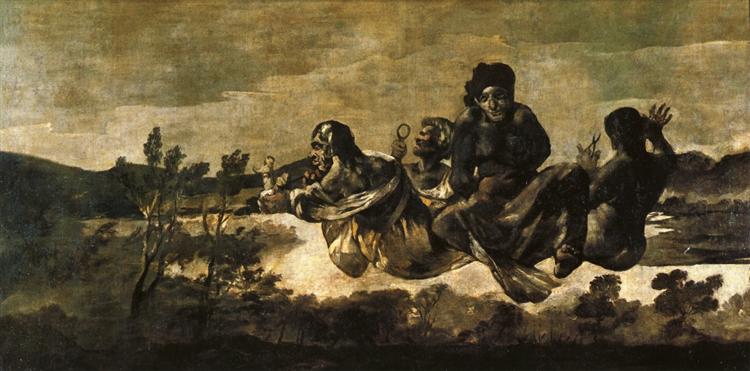Opis
Francisco Goya's Atropos (The Fates), painted in 1823, is a penetrating examination of the themes of fatalism and mortality. In the context of 19th-century Spanish art, Goya is distinguished by his ability to address human anguish through a symbolic and poignant visual language. Part of a series exploring the human condition, this painting is based on the figure of Atropos, one of the three Fates of Greek mythology, who determine the fate of men.
Looking at the composition, it is evident that Goya employs a colour scheme that alternates between dark and light tones, creating a strong contrast that underlines the gravity of the subject. The dark, almost gloomy background benefits from touches of light that prevent the work from falling into mere penumbra. The central figure, representing Atropos, is an austere, imposing and evocative character, as she firmly holds the scissors used to cut the thread of life. This representation not only emphasises her power over fate, but also serves as a reminder of the inevitable suffering that all human beings face.
The faces of Atropos, as well as the features of the surroundings, are marked by a palpable expression of determination and despair. Goya uses the technique of chiaroscuro to give depth and dimension to the figures and the space, which intensifies the atmosphere of disquiet that permeates the work. The treatment of light and shadow enhances not only the physical form, but also the emotional meaning. This representation of death becomes an element of reflection on the fragility of life and the inexorability of fate.
It is interesting to note that although Atropos is a work full of symbolism, it also reflects the historical context in which it was created. In 1823, Spain was facing a deep political and social crisis. The violence and censorship of the reign of Ferdinand VII had created an atmosphere of anguish and uncertainty in Spanish society, and this work seems to capture part of that collective feeling. Goya, through his artistic expression, becomes a chronicler of his time, interweaving the personal and the universal.
In Goya's legacy, this work is part of his stylistic evolution, which goes from Rococo to Romanticism, amalgamating elements of both styles. "Atropos" can be seen as a precursor of symbolism and modernism, where emotions and abstract concepts are translated into visual representations that invite introspection and contemplation. Through this canvas, Goya not only presents us with Atropos, but also confronts us with the perpetual image of our inevitable destiny.
The work as a whole reveals Goya's mastery in articulating his internal and social psychology through art. "Atropos (The Fates)" invites the viewer to meditate on his own existence and the role of fate in it, establishing itself as a milestone in the history of art, where despair and truth are revealed in a single pictorial gesture. This canvas is not only a visual meditation on life and death, but a timeless representation of the relationship we all share with fate.
KUADROS ©, a famous painting on your wall.
Hand-made oil painting reproductions, with the quality of professional artists and the distinctive seal of KUADROS ©.
Painting reproduction service with satisfaction guarantee. If you are not completely satisfied with the replica of your painting, we will refund 100% of your money.

